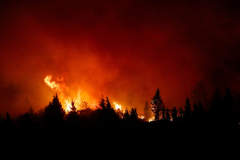- As the effects of climate change become increasingly evident, Latin American countries are facing complex circumstances when it comes to defending themselves against forest fires — and urban fires.
- In Argentinian Patagonia, fires have destroyed more than 10,100 hectares (24,958 acres) of native forests, including areas of Nahuel Huapi National Park. There are also active fires in Chile that have killed three firefighters.
- Mongabay Latam talked to specialists in order to understand what is happening in some of the territories that have been hit hardest by the fires.
- Experts agree that it is urgent for Latin American governments, which often have limited capacity, to double down on their prevention efforts and allocate sufficient resources to fire management strategies, taking timely action against forest fires.
As Los Angeles faced unprecedented fires razing entire neighborhoods in late January, Latin America was not spared either. In Argentinian Patagonia, fires have destroyed more than 10,100 hectares (24,958 acres) since summer began in the Southern Hemisphere. These fires affected Nahuel Huapi National Park, among other areas. In Chile, the forest fires so far in 2025 have killed three firefighters.
In less than a month, the fires in Los Angeles, since they began Jan. 7, destroyed 18,000 homes and structures and killed at least 29 people. Those were not the first large-scale wildfires to occur in this region of the U.S. What set them apart, though, was the fact that they switched from forest fires to urban fires. A similar event occurred in Chile in 2024.
In 2024, Bolivia, Chile, Colombia, Ecuador, Mexico, Paraguay, Peru and Argentina were affected by fires that scorched forests and victimized people, even prompting some of these governments to declare national disasters.

How prepared is the region to face fires in 2025? Current events represent a major warning that must not be ignored. This serves as a special alert for Latin American governments, which have often limited capacity, to work toward preventing fires, allocating sufficient resources to fire management strategies and taking timely action against forest fires. The effects of climate change — such as stronger winds, elevated temperatures and prolonged droughts — are combining with human actions and intentional fires, causing wildfires with catastrophic effects.
“There is an environmental transformation in which fires spread and things become more complicated now, under the effects of climate change on a global scale,” said Enrique Jardel, a Mexican fire management specialist and professor at the Department of Ecology and Natural Resources at the University of Guadalajara.
“We’ve spent half a century discussing fire management, just like we’ve been discussing urban planning, controlling the disorganized expansion of cities and actions to mitigate climate change,” Jardel said. “Now, this is a situation in which those factors are combining and we are seeing the sad and awful example of the fires in Los Angeles, which are occurring in a densely populated region that has gone through a significant landscape transformation and which, due to the characteristics of its climate and vegetation, we can say is one of the most flammable environments in the world,” Jardel added.

“Of course, this is a lesson that we must learn, because similar conditions could happen in Latin America,” he said.
Mongabay Latam talked to several specialists to explain this complex situation in Mexico, Colombia, Argentina, Chile and Bolivia.
Argentina: A fragile fire management system
Since the beginning of 2025, Argentina has faced three large-scale forest fires in the Patagonian region. In the municipality of Epuyén in Chubut province, fire has consumed approximately 3,000 hectares (7,413 acres) of forests. According to reports by several Argentinian media outlets, by Jan. 20, flames had already destroyed at least 50 homes and forced more than 200 families to evacuate the far southern part of the country.
Meanwhile, another fire that began in late December 2024 in Nahuel Huapi National Park has yet to be completely extinguished. To date, it has leveled more than 5,000 hectares (12,355 acres) of this forest reserve near the border with Chile. The situation is critical: The combination of dry weather, a lack of rain, strong winds and a weak government response have complicated the outcome.

“Argentina does not seem to be prepared on a provincial or national level for a climate crisis scenario that, especially in the summertime, puts Patagonian Andean forests much more at risk,” said Hernán Giardini, the forests campaign coordinator for Greenpeace Argentina.
In late January, a third fire erupted in the area. It damaged 2,000 hectares (4,942 acres) of native forests and pastures in Chubut province, in the rural commune of Doctor Atilio Oscar Viglione, according to Giardini.
The specialist said these fires are an example of the fragility of the country’s fire management system. “On a national scale, the resources for environmental issues as a whole have been reduced. There has been a political decision to not put much money into the environment, which will have medium-term repercussions; for example, with the firefighters who are in a fragile work situation,” Giardini explained.

The firefighters do not have permanent contracts, and they are understaffed in comparison with the areas they must serve. Each time a fire ignites, other groups of firefighters must be mobilized from other provinces to the affected areas.
Giardini emphasized the need for more investment in fire prevention and rapid-response infrastructure, in addition to stricter legislation to penalize intentional forest destruction. “On both a provincial and national level, prevention efforts [and] infrastructure for rapid fire response must be increased significantly,” Giardini said.
He suggested it is necessary for “the Congress of the nation to work on bills that have remained, in many cases, without progress [in terms of] penalizing the illegal destruction of forests, whether that is by converting them using deforestation or using fires. That would be another important tool to stop those who are trying to destroy the two forests illegally,” Giardini said.
Colombia: The risks of fighting the fire
Since the start of the year, in Colombia, high temperatures and the dry season have already caused fire threat alerts for 304 municipalities, mostly located in the Andean region. This is according to Colombia’s Institute of Hydrology, Meteorology and Environmental Studies in its Jan. 20 report. According to authorities, the country is experiencing weather with very few clouds and little rain, along with high temperatures and high levels of solar radiation. These factors have dried out the vegetation, converting it into potentially flammable material.

“Strong winds and previously deforested areas can make it so that, with dry, accumulated biomass, ready to be burned, the fire spreads rapidly,” said Rodrigo Botero, director of the Foundation for Conservation and Sustainable Development. “As far as I know, there is not a single country in Latin America with a controlled burning system for the reduction of plant biomass,” Botero said.
According to Botero, the Colombia’s National Unit for Disaster Risk Management (UNGRD in Spanish) has shown that it has a good capacity to obtain and distribute information. Not only does the entity have





